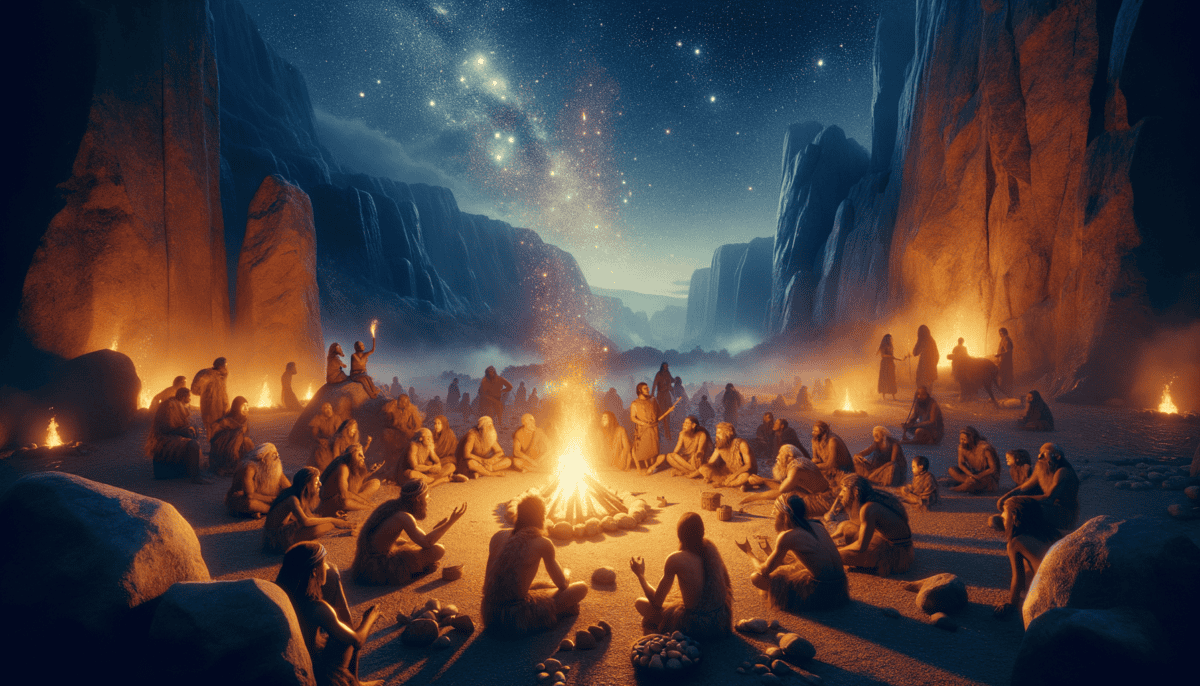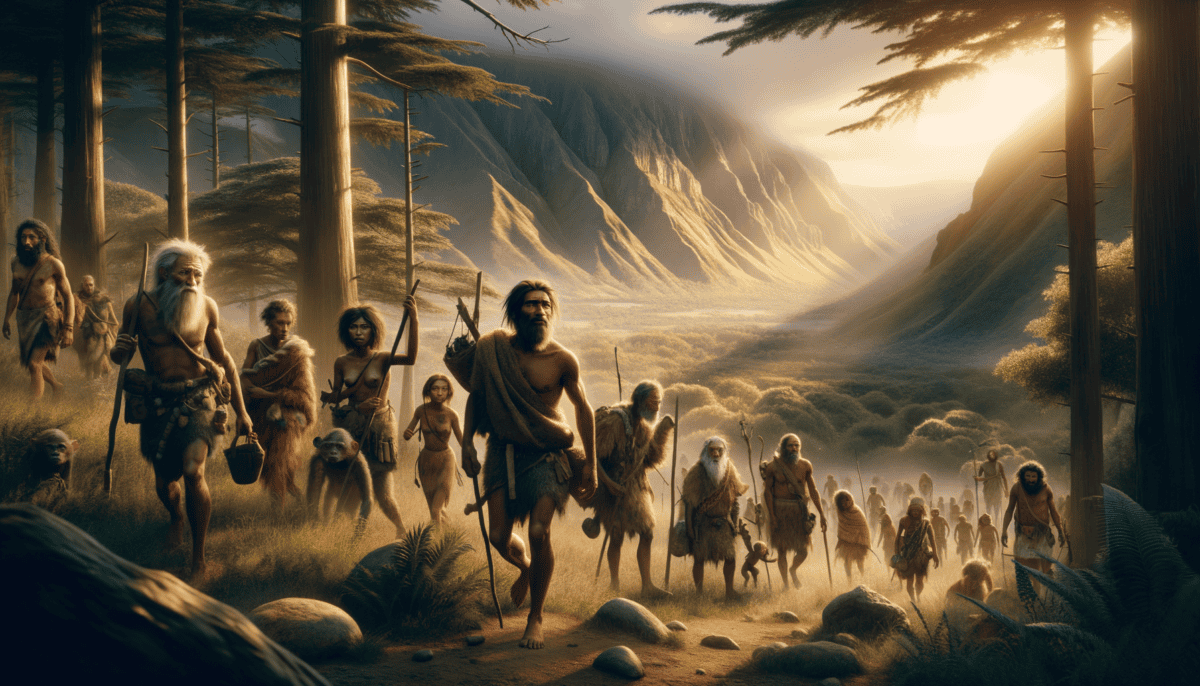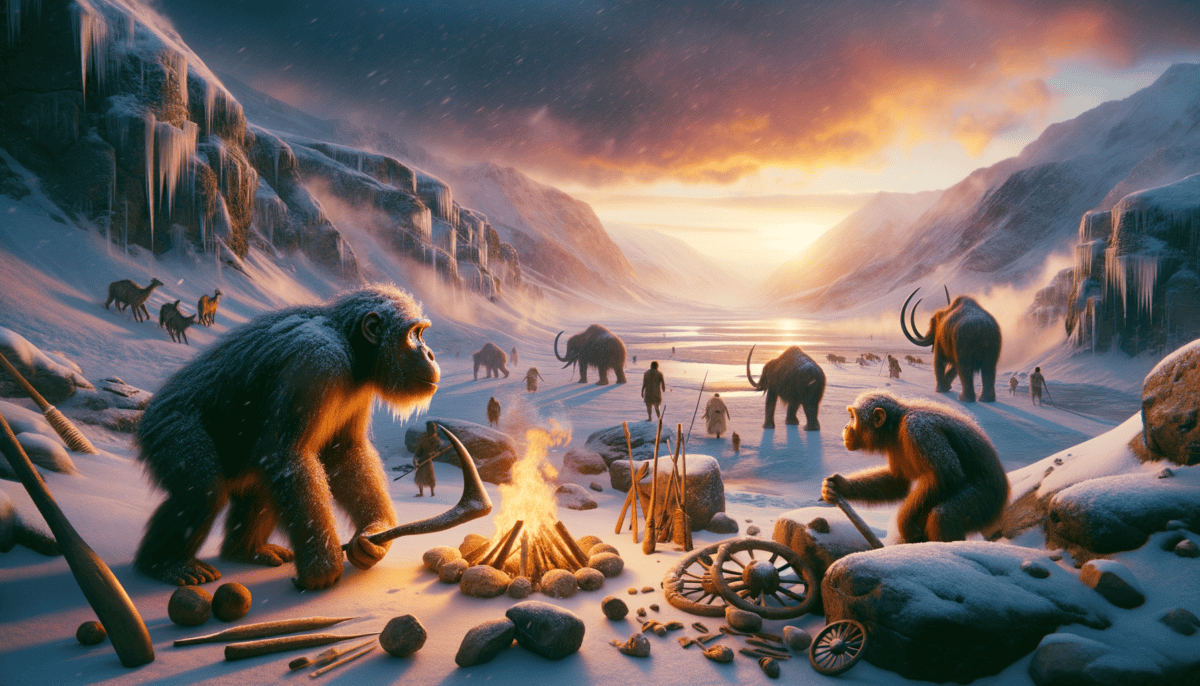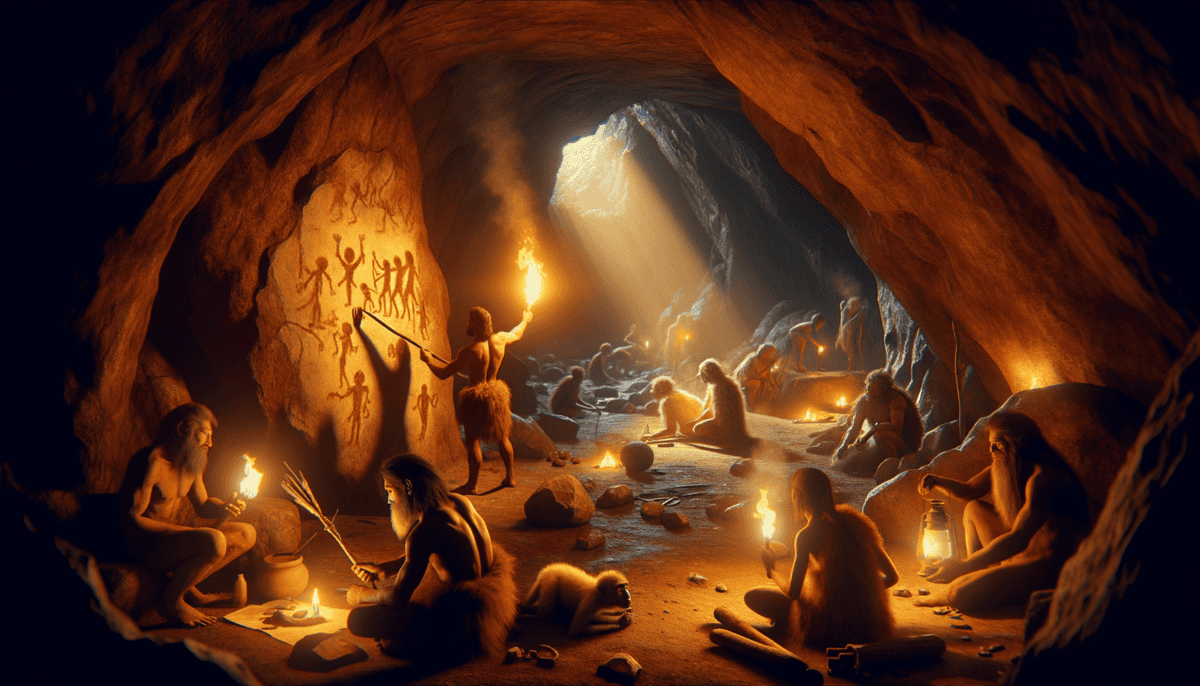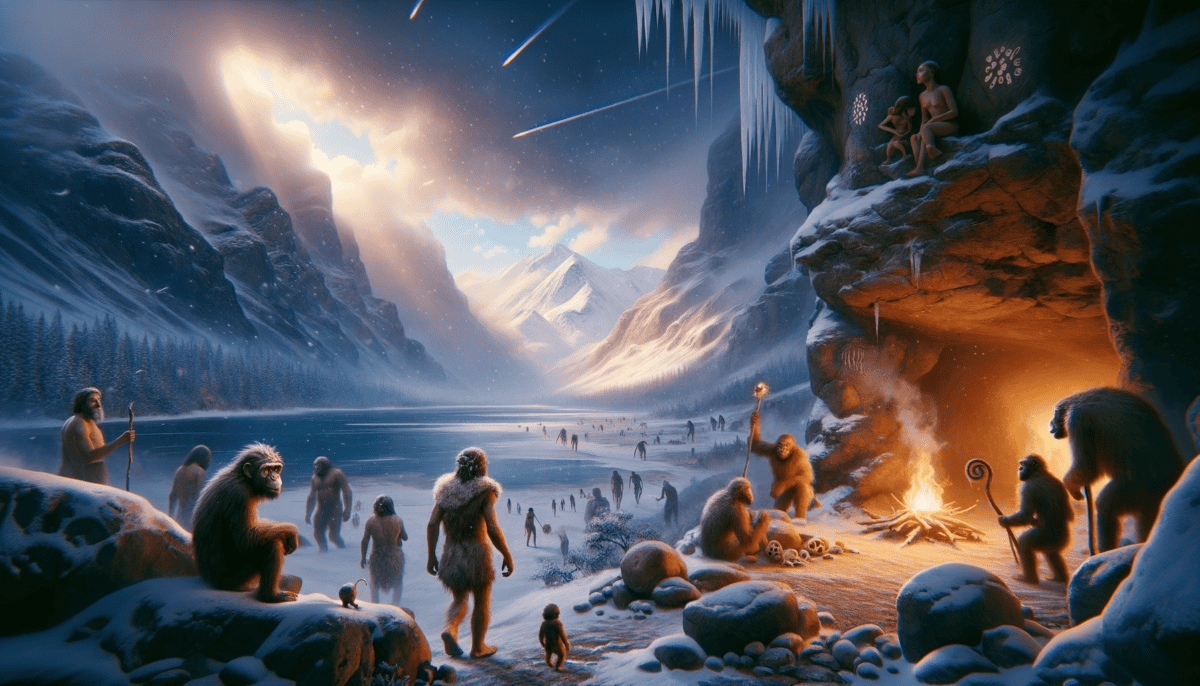Awakening in a Harsh World
The bright African sun rose over the tall grass, warming the savanna. Zara, a young prehistoric girl with dark curly hair, stood next to her mother. They watched the golden light spread across their home.
"Look, little one," her mother whispered, pointing to a herd of gazelles in the distance. "That's our breakfast – if we're clever enough to catch it."
The savanna was beautiful but dangerous. Lions prowled through the grass. Huge eagles soared overhead. Every day brought new challenges for Zara's family.
Living with Danger
Zara's people were small compared to the animals around them. They didn't have sharp claws or strong teeth. But they had something special – big brains!
"We must be smarter than the lions," Zara's father often said. "We can't fight them, but we can outsmart them."
Their group worked together to stay safe. Some people watched for danger while others gathered food. When someone spotted a threat, they made special sounds to warn everyone.
Tools Make Life Better
Zara loved watching the tool makers work. They carefully broke stones to make sharp edges. These tools helped them:
• Cut meat and plants
• Dig for roots
• Break open nuts
• Make wooden spears
"Every tool makes us stronger," the old toolmaker would say as he showed Zara how to chip stones. "With these, we can get food that other animals can't reach."
Working Together
As the sun climbed higher, Zara's group gathered to plan their day. Some would hunt, others would gather berries and roots. The children would help collect water from the river.
"Remember," said the group leader, "we are strongest when we work as one."
They didn't speak like we do today. Instead, they used simple sounds, hand signals, and facial expressions. But they understood each other well enough to hunt and share food.
Finding Food
Zara followed her mother to gather berries. They had to be careful – some plants could make you sick. Her mother showed her which berries were safe by pointing to their color and shape.
"Look how the birds eat these," her mother gestured. "If they're safe for birds, they're safe for us."
Later that day, the hunters returned with a gazelle. Everyone gathered around as they shared the meat. Nobody ate alone – sharing food helped the whole group survive.
A Night Under the Stars
As darkness fell, the group huddled together for warmth and safety. The night was full of dangerous sounds – roaring lions, laughing hyenas, and rustling grass.
Zara snuggled close to her mother, looking up at the stars. Despite all the dangers, their group was strong. They had their tools, their knowledge, and most importantly, they had each other.
The cool night air carried the sounds of their group – soft breathing, quiet movements, and occasional whispers. Tomorrow would bring new challenges, but together, they would face them all.
The Fire Makers
A flash of lightning split the sky. Thunder boomed across the savanna. Zara and her family huddled in their shelter, watching nature’s power show. But this storm would change their lives forever.
A Magical Discovery
“Look!” Zara pointed excitedly. A tree struck by lightning was burning bright in the darkness. Unlike most of her group who backed away scared, Zara felt drawn to the warm, dancing light.
Her father, the brave hunter Kato, noticed something interesting. “The fire keeps the night animals away,” he gestured to the others. Sure enough, no lions or hyenas came near the burning tree.
Learning to Keep the Fire
At first, they could only use fire when lightning made it. But Kato had an idea. He grabbed a burning branch and brought it back to their shelter. They fed it with dry grass and sticks to keep it alive.
“We must never let it die,” Zara’s mother Maya showed the children how to add small sticks to the fire. “It gives us light, warmth, and safety.”
Better Tools, Better Life
The fire changed how they made tools too. They discovered that heating stones made them easier to shape. Their tools became sharper and stronger.
Here’s what fire helped them do:
• Cook food and make it tastier
• Stay warm during cold nights
• Scare away dangerous animals
• Make better tools
• See in the dark
Hunting Gets Easier
With fire, hunting changed too. They could cook meat, making it softer and yummier. Cooked food gave them more energy to run and think.
“Watch how the meat changes color,” Maya showed Zara, holding a piece over the flames. “When it turns brown, it’s ready to eat.”
Sharing Knowledge
As the group sat around the fire at night, something magical happened. They started sharing more stories through gestures and sounds. The fire’s light let them see each other’s faces better, making it easier to communicate.
The older members taught the younger ones about:
Which plants were good to eat
How to avoid dangerous animals
The best ways to make tools
♀️ Secret hunting tricks
A New Way of Living
The fire became the heart of their camp. Each night, families gathered around it, sharing food and staying warm. Even during the day, someone always watched the fire to keep it burning.
“The fire is like a friend,” Zara thought as she watched the flames dance. “It protects us and helps us live better.”
One evening, as the group sat around their fire, they heard strange sounds from far away. Other groups of people had seen their fire! Soon, they would meet new friends and learn new ways to survive. But that’s a story for another time…
Beyond the Homeland
The morning sun peeked over distant mountains Zara had never seen before. Her family and tribe had walked farther than ever from their home. The air felt different here – cooler and thinner.
A New Adventure
“Why are we going so far?” Zara asked her father Kato, who carried their precious fire in a special hollow log.
“The seasons are changing,” he explained. “We must find new places with more food and safer shelters.”
Strange New Lands
Each day brought new sights that made Zara’s eyes grow wide:
• Tall mountains covered in white stuff called snow
• Huge forests with trees bigger than any they’d seen
• Wide rivers full of fish
• Rocky caves that could keep them warm and dry
• Green valleys with lots of animals to hunt
“Look!” Maya pointed to tracks in the mud. “These animals are different from the ones at home.”
Learning New Ways
The tribe had to learn fast to survive in these new places. The old ways didn’t always work here. Zara watched as her family figured out clever solutions:
They found new plants that were good to eat
They made better spears for hunting bigger animals
They built stronger shelters using branches and animal skins
They made foot covers from animal hide to walk on cold ground
Meeting New Friends
One day, they saw smoke from another fire in the distance. At first, they were scared. But when they got closer, they found other people who looked a bit different but were just like them.
“They have fire too!” Zara said excitedly, watching the other group.
Though they spoke differently, the two groups learned to trade. The new friends showed them:
Where to find good stones for tools
The best places to hunt
Hidden water spots
Which new plants were safe to eat
Getting Stronger
Each challenge made them smarter and stronger. They learned to:
“Watch how the fish swim upstream,” Kato showed Zara. “That’s the best place to catch them.”
Maya taught everyone to weave grass into baskets. “Now we can carry more food,” she smiled proudly.
A World of Wonders
As seasons passed, Zara’s tribe grew better at living in new places. They weren’t just surviving – they were learning and growing stronger.
“Every day we learn something new,” Zara thought as she watched the sunset over unfamiliar hills. “Every place teaches us something different.”
That night, as they sat around their fire in a new cave home, Zara heard strange sounds echoing from far away. The weather was getting colder, and bigger changes were coming. But Zara wasn’t scared anymore – she knew her tribe could handle anything together.
The Great Cold
White flakes fell from the sky, covering everything in a soft blanket. Zara had never seen anything like it before. The air was so cold it made her breath look like smoke. ️
A Chilly Challenge
“What is this, Papa?” Zara asked, catching a snowflake on her hand.
“This is snow, little one,” Kato smiled. “It means we must prepare for the hardest season yet.”
Keeping Warm
The tribe worked together to survive the cold. Maya showed everyone how to make warm clothes:
They used animal furs to make coats
They made boots from thick leather
They created mittens to keep hands warm
They built snug shelters with mammoth bones and skins
“See how the fur keeps the animals warm?” Maya explained. “It can keep us warm too!”
Big Game Hunting
Huge animals roamed the snowy plains. Woolly mammoths towered over the hunters, with long curved tusks and thick brown fur.
“We must be very clever to hunt such big animals,” Kato told the tribe. Everyone worked as a team:
• Some made strong spears
• Others dug clever traps
• The fastest runners led the animals where they wanted
• The strongest threw the spears
Storing Food
Zara learned new ways to keep food for later:
“Watch how we dry the meat in the cold wind,” her mother showed her. “It will last many moons this way.”
They also:
Smoked meat over fires
❄️ Stored food in cold caves
️ Dug snow pits to keep meat frozen
Made special baskets for berries and nuts
Cozy Cave Homes
Their cave home became more comfortable. They:
Kept the fire burning day and night
️ Made soft beds from fur and grass
Built walls from bones and skins
Used rocks to block cold wind
“Our cave is as warm as summer now!” Zara said happily, snuggling in her fur blanket.
Winter Fun
Even in the cold, they found ways to enjoy themselves:
“Look what I can do!” Zara laughed, sliding down a snowy hill on a piece of bark.
Children made shapes in the snow and had throwing contests with snowballs. The tribe shared stories around the fire at night, staying cozy while the wind howled outside.
Signs of Change
As the tribe mastered life in the cold, they noticed strange marks on cave walls. Someone else had lived here before. Who were they? What stories did these cave paintings tell?
That night, as shadows danced on the cave walls, Zara wondered about these other people. Maybe they could learn from their pictures, just as they had learned to survive in this icy world.
Pictures on the Wall
Zara stared at the cave paintings in wonder. Red and black shapes danced across the stone. Some looked like animals she knew. Others were strange and new.
Making Colors
“How did they make such pretty pictures?” Zara asked Maya.
Maya smiled and showed her their special paint-making tools:
• Red rocks they could crush
• Black charcoal from fires
• Animal fat to mix with colors
• Soft hair brushes
• Hollow bones to blow paint
Learning to Paint
The tribe gathered to make their own pictures. They used their hands to make prints on the wall. They drew the animals they hunted.
“Look!” Zara giggled. “I made a woolly mammoth!” Her painting showed a big furry animal with long tusks.
Special Tools
Kato showed everyone how to make better tools:
Sharp stone axes with wooden handles
️ Strong spears with bone tips
Clever hooks for catching fish
Tiny needles made from bone
“These tools make our work easier,” Kato explained. “Just like our parents taught us, we must teach others.”
Living Together
The tribe grew bigger. More families joined them in their warm cave. They made rules to help everyone get along:
Share food with everyone
Help those who are sick or hurt
Take care of the children together
️ Listen to the wise elders
Special Ceremonies
At night, the tribe gathered for special times:
“Watch the shadows dance,” the elder said, moving his hands in the firelight. He told stories about their ancestors and the spirits of the land.
They made music with:
Drums from animal skins
Whistles from hollow bones
Clapping and stomping
Songs about their hunts
New Friends
One day, strangers came to their cave. They looked different, but they also had tools and paintings.
“Welcome!” Zara’s tribe shared their fire and food. The new people taught them different ways to make tools and paint pictures.
That night, both groups sat together, sharing stories through pictures and signs. Even though they spoke different words, they understood each other through their art.
As Zara fell asleep, she thought about all the new things they learned. The cave walls held their stories, just like the ones they found when they first came. Maybe someday, other people would find their pictures and learn from them too.
A New Way of Life
The warm sun peeked over the hills as Zara watched the seeds her tribe had planted. Tiny green shoots were poking through the soil.
Growing Food
“They’re growing!” Zara danced around the field. “Just like you said they would, Maya!”
Maya smiled and gently touched the small plants. “Yes, little one. Now we can grow our own food instead of always hunting for it.”
• Wild wheat
• Berries
• Roots
• Herbs
Building Homes
The tribe started building houses near their gardens. They used:
Strong tree branches for walls
Thick grass for the roof
Big stones for the base
Mud to fill the gaps
“This will be our forever home,” Kato said, helping to build a new house. “We won’t have to move so much anymore.”
Meeting New Friends
More people came to live near them. Some brought animals they had made friendly:
Dogs that helped hunt
Sheep that gave wool
Goats that gave milk
Birds that gave eggs
Trading with Others
“Look what I got!” Zara showed her new shell necklace. She had traded some berries for it with people from far away.
Everyone shared different things:
Pretty stones
Woven baskets
Clay pots
Warm clothes
Teaching and Learning
The elders taught the children many things:
“Watch how the stars move,” they said. “They tell us when to plant seeds.”
“Listen to the birds,” they showed. “They warn us about storms.”
“Remember our stories,” they sang. “They help us know who we are.”
The Big Celebration
When the plants gave lots of food, everyone had a big party. They danced, sang, and shared meals together.
“We have come so far,” Maya said, watching the happy people. “From running from big cats to growing our own food. From hiding in caves to building homes.”
Zara looked at their village. She saw the gardens full of food, the cozy houses, and all the smiling faces. She thought about the cave paintings that showed their long journey.
“We learned so many things,” she said. “And we’re still learning more!”
That night, as the stars twinkled above their new village, Zara knew this was just the beginning. Their tribe had found new ways to live, and they would keep finding more. They had learned that together, they could do amazing things.


